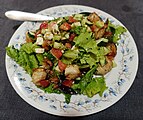| Pollotarianism | |
|---|---|
 Chicken and vegetables; foodstuffs compatible with a pollotarian diet | |
| Description | |
| A diet in which poultry is the only meat | |
| Related Dietary Choices | |
| Related diets | |
| Diet classification table | |
| Plants | Dairy | Eggs | Seafood | Poultry | All other animals | ||
|---|---|---|---|---|---|---|---|
| Vegetarianism | Ovo-lacto vegetarianism | Yes | Yes | Yes | No | No | No |
| Ovo vegetarianism | Yes | No | Yes | No | No | No | |
| Lacto vegetarianism | Yes | Yes | No | No | No | No | |
| Veganism | Yes | No | No | No | No | No | |
| Semi-vegetarianism | Flexitarianism | Yes | Yes | Yes | Sometimes | Sometimes | Sometimes |
| Pollotarianism | Yes | Maybe | Maybe | Maybe | Yes | No | |
| Pescetarianism | Yes | Maybe | Maybe | Yes | No | No | |
Pollotarianism is the practice of adhering to a diet that incorporates poultry as the only source of meat in an otherwise vegetarian diet.[1][2]
While pollo specifically means chicken in both Spanish and in Italian (with pollame meaning poultry in general in Italian), pollotarians are known to incorporate different forms of poultry, like duck and turkey in their diet.[3] Pollotarians may also eat dairy products.[4] The term "pollo-vegetarian" was first used in nutritional textbooks in the 1980s to describe a semi-vegetarian diet that incorporates poultry.[5][6][7] Historian Rod Preece describes pollotarians as "those who refrain from mammals but are willing to eat the flesh of birds notably chickens."[8]
Reasons why people adopt a pollotarian diet ranges from health concerns arising from consumption of red meat while not willing to either give up meat altogether or not wanting to compromise on nutrients to reducing one's carbon footprint to ethical reasons.[9]